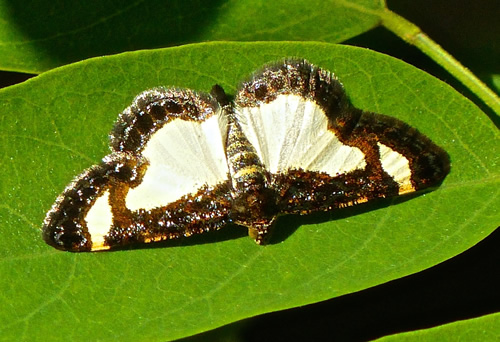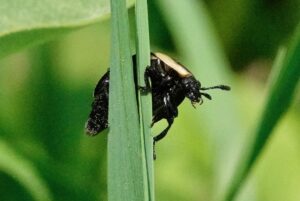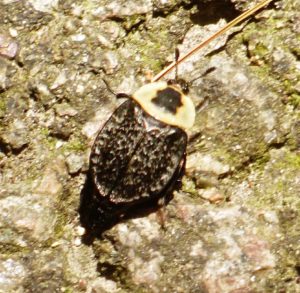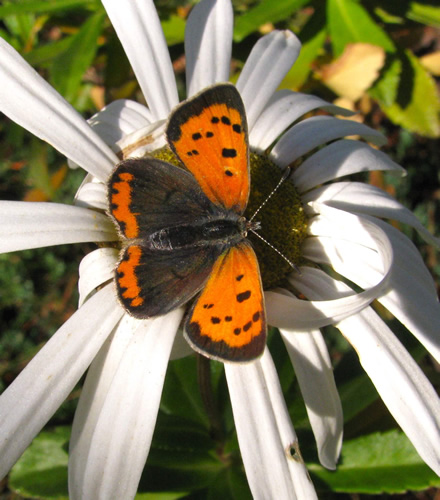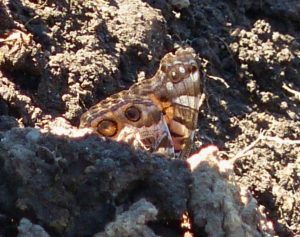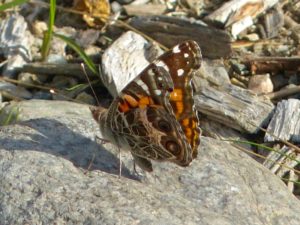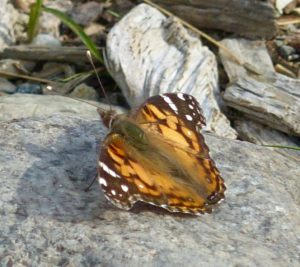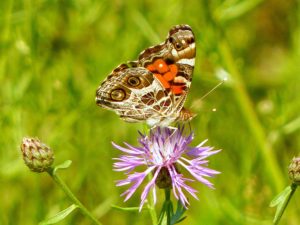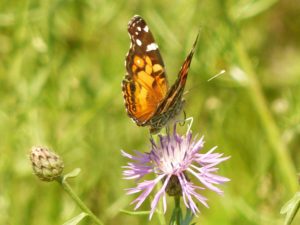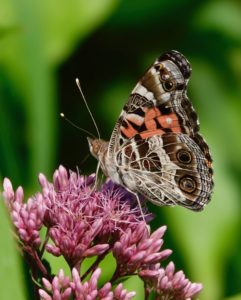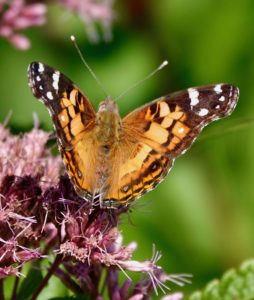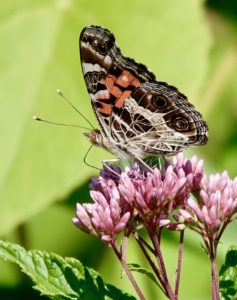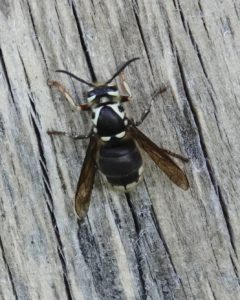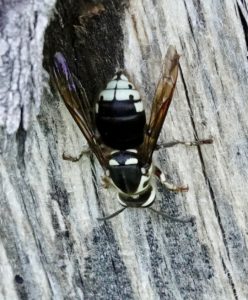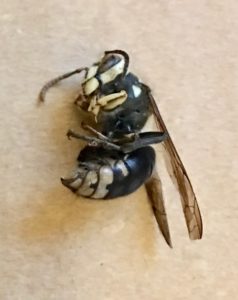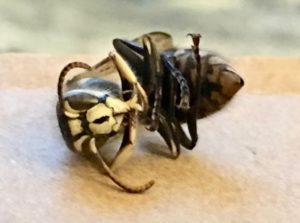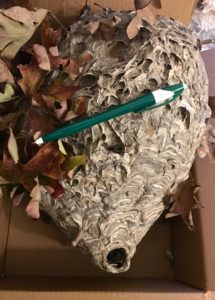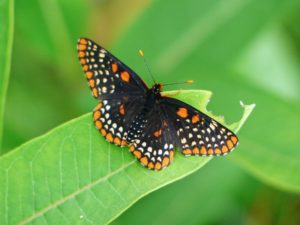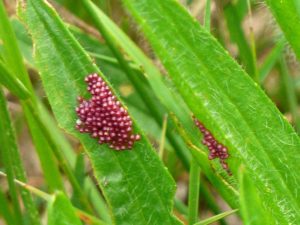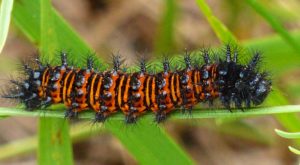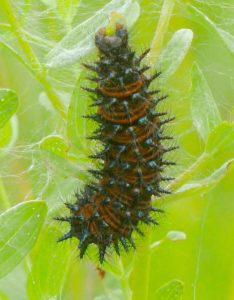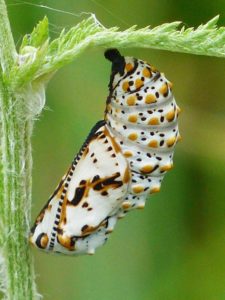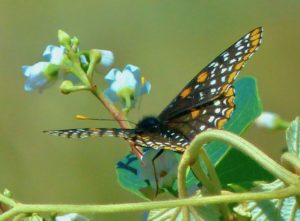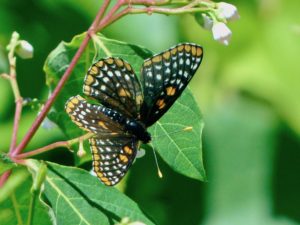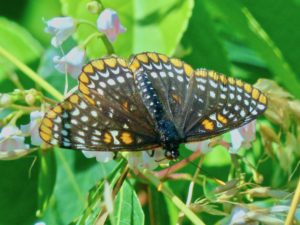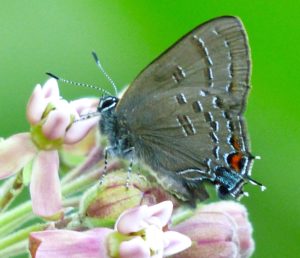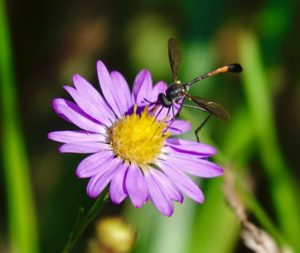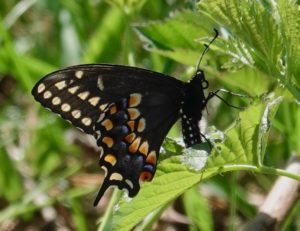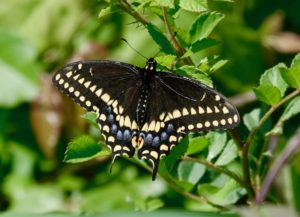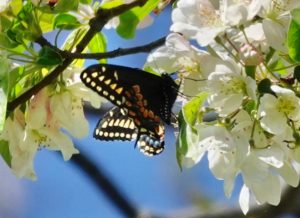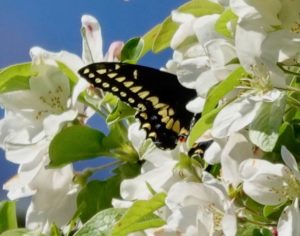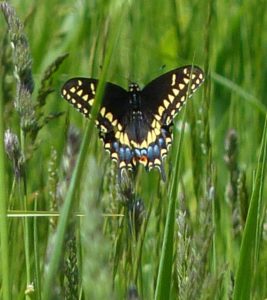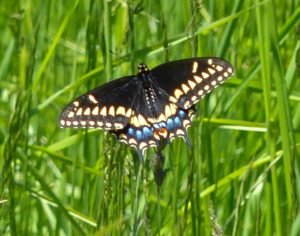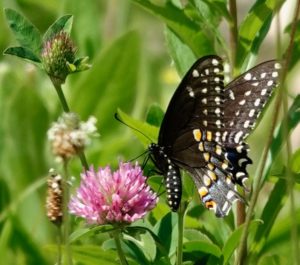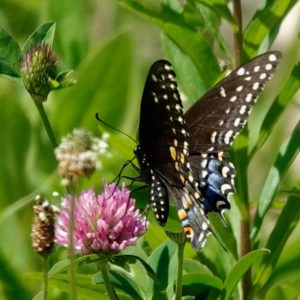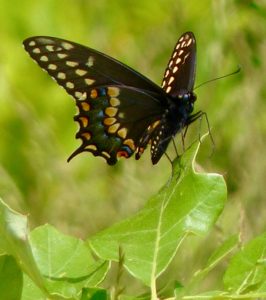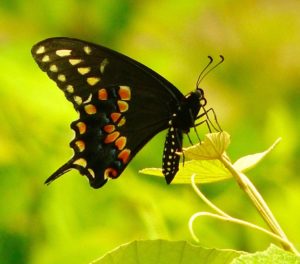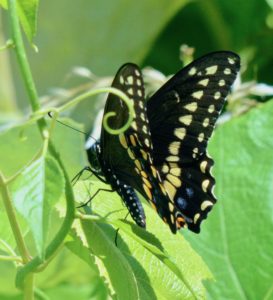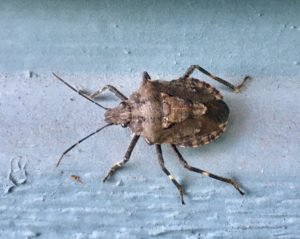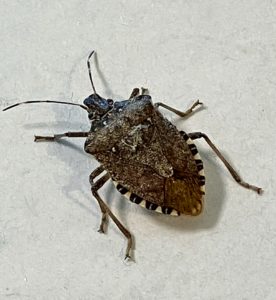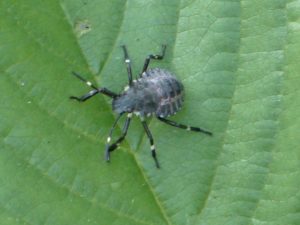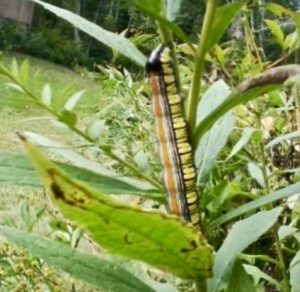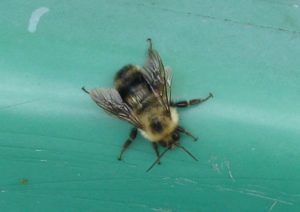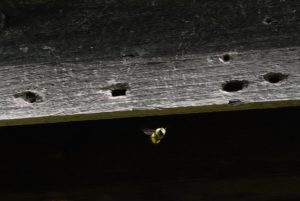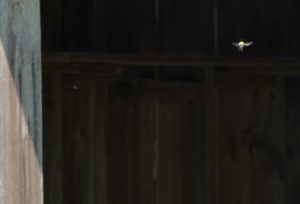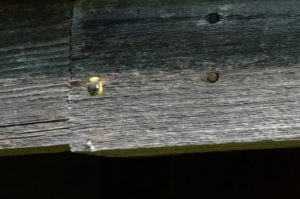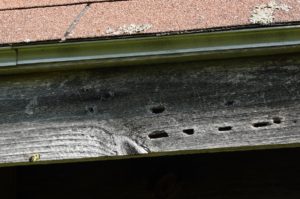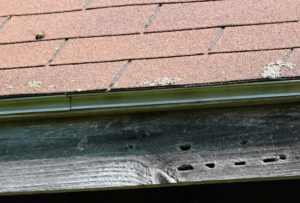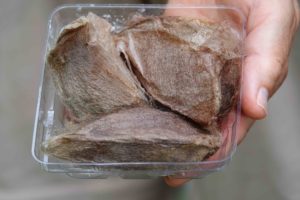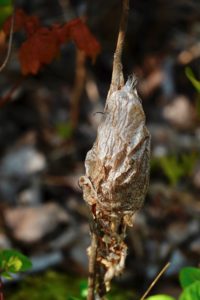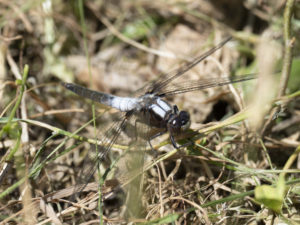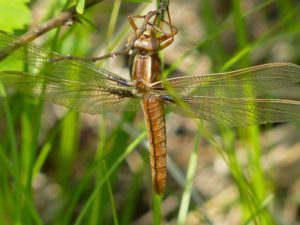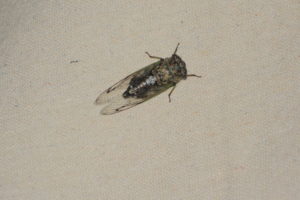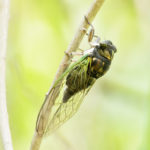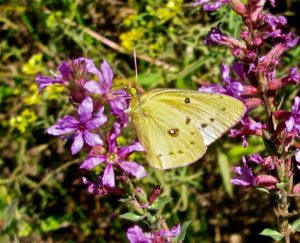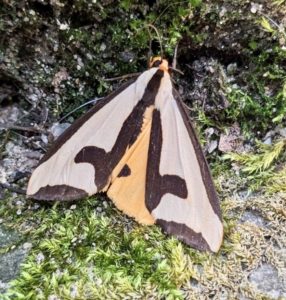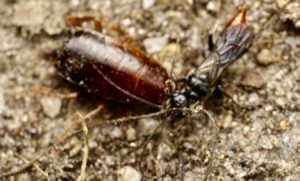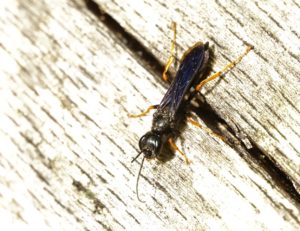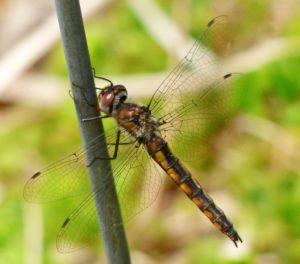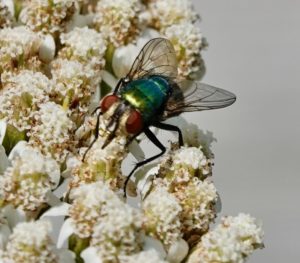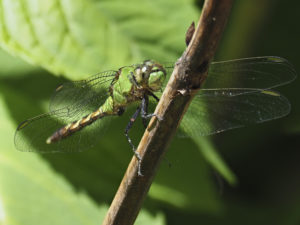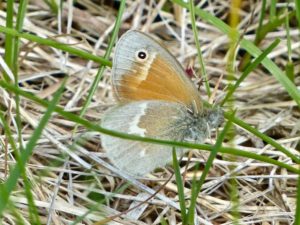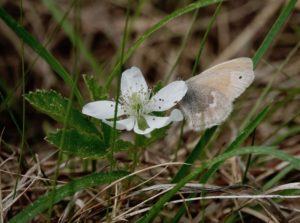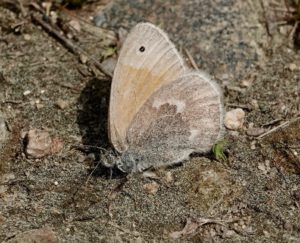Sightings – Insects and Spiders
Observer: Paul Lauenstein
Observation Date: 6/4/24
Observation Time: 12:40 p.m.
Observation Location: Moose Hill Farm (T.T.O.R.)
Common Name: American Carrion Beetle
Scientific Name: Necrophilia americana
Comments: From spring through fall, during daylight, a few hours after flies begin arriving at a carcass, the adult beetles will arrive as well. They immediately begin eating the already hatching fly larvae, mating, and laying their own eggs. As long as the carcass lasts, the adults will remain eating competitors to give their own larvae a chance to eat and grow. Upon hatching from the eggs, the larvae will eat both the carcass and other larvae that are within it. Eventually the larvae will fall to the ground, dig into the dirt, and pupate. Overwintering is done by adults.
More Information: Wikipedia
Observer: Paul Lauenstein
Observation Date: 8/6/15
Observation Time: 12:50 p.m.
Observation Location: Gavins Pond area
Common Name: American Carrion Beetle
Scientific Name: Necrophilia americana
Comments: From spring through fall, during daylight, a few hours after flies begin arriving at a carcass, the adult beetles will arrive as well. They immediately begin eating the already hatching fly larvae, mating, and laying their own eggs. As long as the carcass lasts, the adults will remain eating competitors to give their own larvae a chance to eat and grow. Upon hatching from the eggs, the larvae will eat both the carcass and other larvae that are within it. Eventually the larvae will fall to the ground, dig into the dirt, and pupate. Overwintering is done by adults.
More Information: Wikipedia
Observer: Paul Lauenstein
Observation Date: 10/18/12
Observation Time: 2:15 p.m.
Observation Location: 4 Gavins Pond Road (front yard)
Common Name: American Copper Butterfly
Scientific Name: Lycaena phlaeas
Comments: This small but colorful butterfly can be seen all summer and into the fall.
More Information: Butterflies and Moths
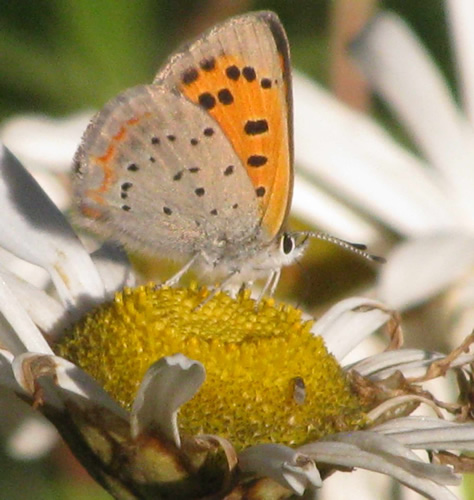
Observer: Paul Lauenstein
Observation Date: 5/12/12
Observation Time: 6:00 p.m.
Observation Location: Furnace St. under high tension wires
Common Name: American Copper Butterfly
Scientific Name: Lycaena phlaeas
Comments: This individual was chasing another to mate.
More Information: Butterflies and Moths
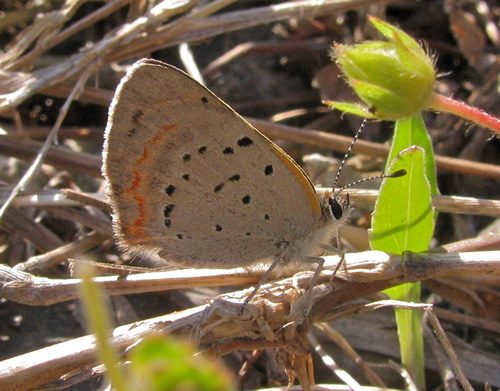
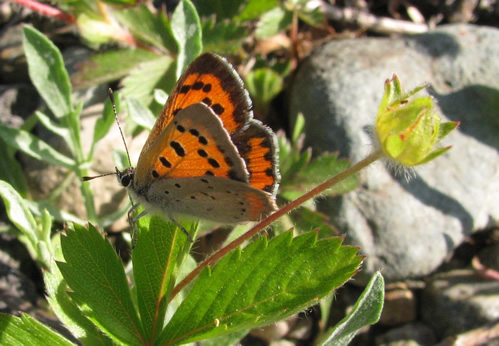
Observer: Paul Lauenstein
Observation Date: 5/21/14
Observation Time: 1:20 p.m.
Observation Location: field near Gavins Pond dam
Common Name: American Copper Butterfly
Scientific Name: Lycaena phlaeas
Comments: Like many small butterflies, the American copper
is a stunning sight when viewed up close.
More Information: Butterflies and Moths
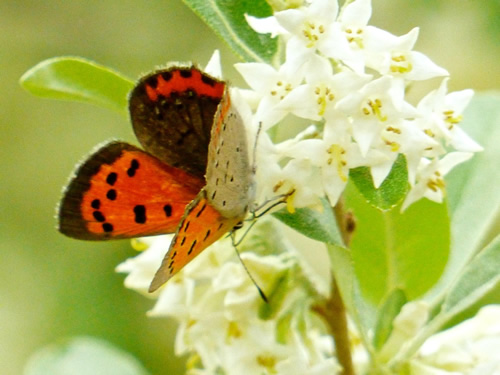
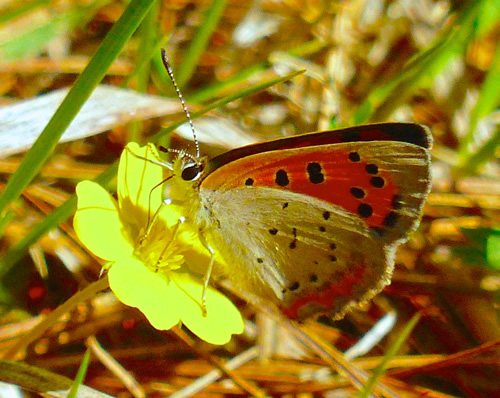
Observer: Paul Lauenstein
Observation Date: 10/5/12
Observation Time: 3:55 p.m.
Observation Location: 4 Gavins Pond Road
Common Name: American Lady Butterfly
Scientific Name: Vanessa virginiensis
Comments: This American Lady butterfly was feeding on Nippon daisies blooming in our garden. There was also a Painted Lady butterfly, which looks very similar, but has four small spots on the undersides of its trailing wings instead of the American Lady’s two large ones.
More Information: BugGuide
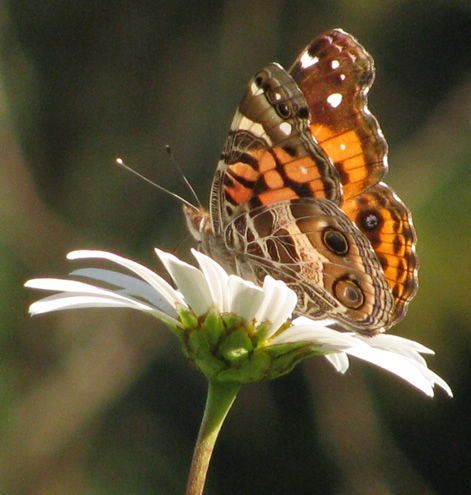
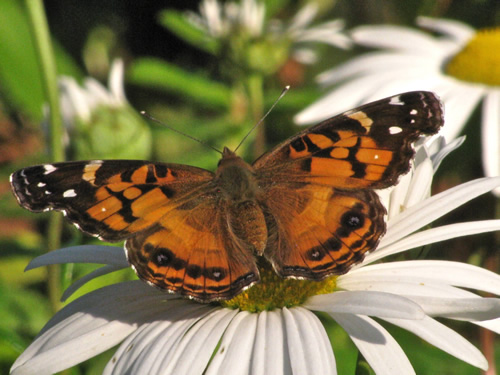
Observer: Paul Lauenstein
Observation Date: 5/12/12
Observation Time: 6:15 p.m.
Observation Location: Gavins Pond Road near Well #5
Common Name: American Lady Butterfly
Scientific Name: Vanessa virginiensis
Comments: American lady butterflies (V. virginiensis) have two large eyespots on the underside of the hind wing, whereas similar-looking painted lady butterflies (V. cardui) have four small eyespots. This individual was feeding on a flowering shrub.
More Information: See Butterflies and Moths of North America.
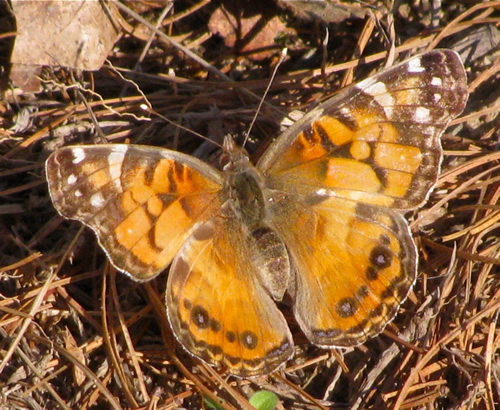
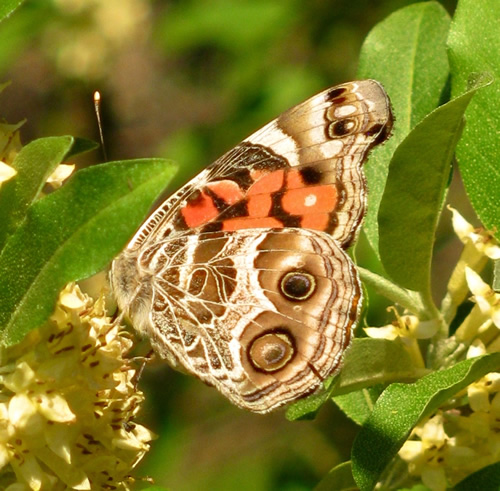
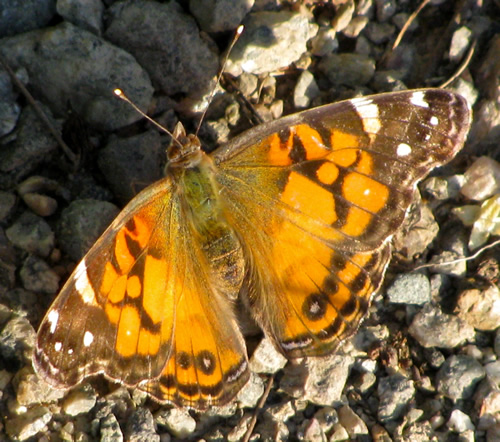
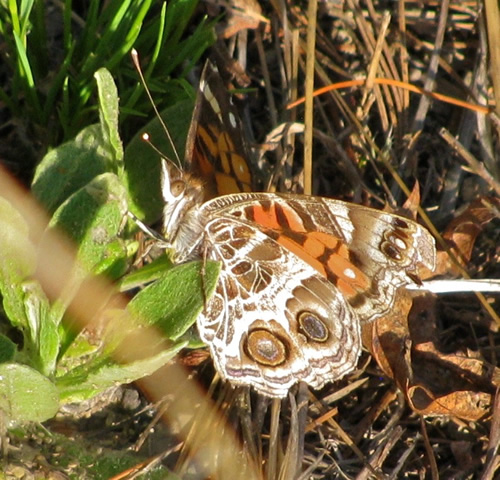
Observer: Paul Lauenstein
Observation Date: 5/26/19
Observation Time: 1:15 p.m.
Observation Location: Moose Hill Farm (formerly the Kendall Estate)
Common Name: American Lady butterfly
Scientific Name: Vanessa virginiensis
Comments: American Lady butterflies look a lot like Painted Lady butterflies. The American Lady has two large spots on the undersides of its trailing wings. The Painted Lady has four smaller spots instead. This Amerian Lady was visiting a mud puddle, but it flew off before I could get a better photo.
More Information: BugGuide
Observer: Paul Lauenstein
Observation Date: 5/27/19
Observation Time: 5:20 p.m.
Observation Location: under the high tension wires across the street from Ward’s Berry Farm
Common Name: American Lady butterfly
Scientific Name: Vanessa virginiensis
Comments: American Lady butterflies look a lot like Painted Lady butterflies. The American Lady has two large spots on the undersides of its trailing wings. The Painted Lady has four smaller spots instead. This Amerian Lady was visiting a mud puddle, but it flew off before I could get a better photo.
More Information: Butterflies and Moths of North America
Observer: Paul Lauenstein
Observation Date: 6/24/11
Observation Time: 2:15 p.m.
Observation Location: Gavins Pond
Common Name: American Lady Butterfly
Scientific Name: Vanessa virginiensis
Comments: American Lady butterflies have two distinctive eyespots on the brown underside of the lower wings. The upper sides of the wings are orange and black.
More Information: See: http://bugguide.net/node/view/236368
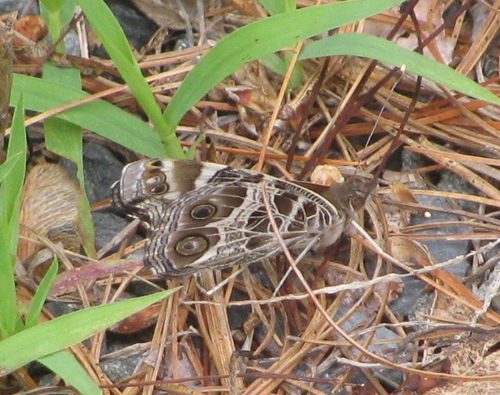
Observer: Paul Lauenstein
Observation Date: 7/11/15
Observation Time: 2:35 p.m.
Observation Location: Gavins Pond
Common Name: American Lady butterfly
Scientific Name: Vanessa virginiensis
Comments: American Lady butterflies look a lot like Painted Lady butterflies. The American Lady has two large spots on the undersides of its trailing wings. The Painted Lady has four smaller spots instead. This Amerian Lady was feeding on a spotted knapweed blossom.
More Information: BugGuide
Observer: Paul Lauenstein
Observation Date: 8/18/20
Observation Time: 11:40 a.m.
Observation Location: Moose Hill Farm (formerly the Kendall Estate)
Common Name: American Lady butterfly
Scientific Name: Vanessa virginiensis
Comments: American Lady butterflies look a lot like Painted Lady butterflies. The American Lady has two large spots on the undersides of its trailing wings. The Painted Lady has four smaller spots instead. This Amerian Lady was feeding on a blossom of a Joe Pye weed.
More Information: Butterflies and Moths of North America
Observer: Paul Lauenstein
Observation Date: 6/19/13
Observation Time: 4:50 p.m.
Observation Location: Gavins Pond area
Common Name: Appalachian Brown Butterfly
Scientific Name: Satyrodes appalachia
Comments: Easily confused with Eyed Brown Butterfly (Satyrodes eurydice). See: http://www.naba.org/chapters/nabambc/frames-2species.asp?sp1=Satyrodes-eurydice&sp2=Satyrodes-appalachia
More Information: Mass Audubon
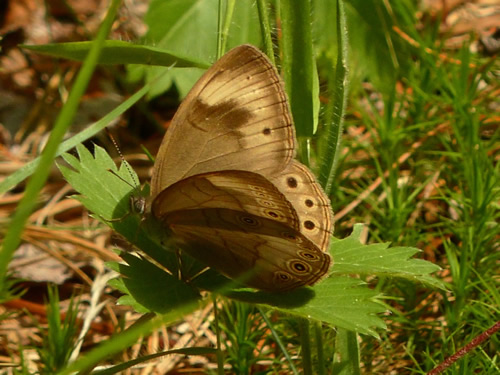
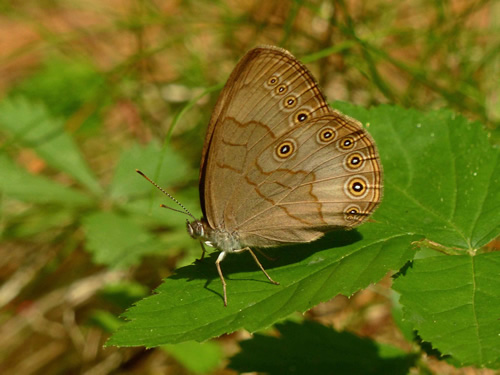
Observer: Paul Lauenstein
Observation Date: 6/21/10
Observation Time: 10:40 a.m.
Observation Location: Beaver Brook near tennis courts
Common Name: Aurora Damsel
Scientific Name: Chromagrion conditum
Comments: When perched, the aurora damsel keeps its wings spread, unlike other damselflies that fold their wings above their abdomens.
More Information: Visiting Nature
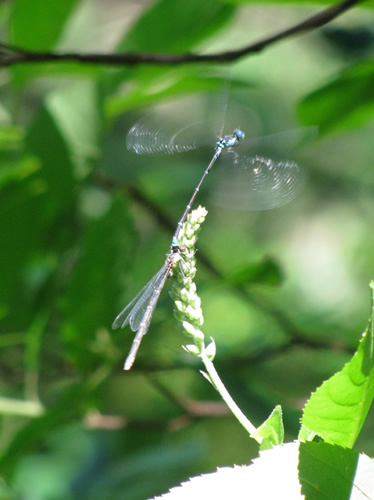
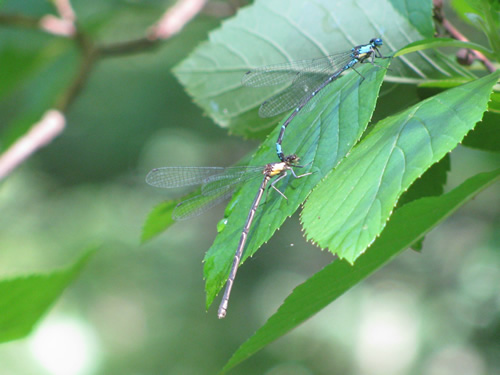
Observer: Paul Lauenstein
Observation Date: 5/30/20
Observation Time: 4:30 p.m.
Observation Location: Moose Hill Farm (TTOR)
Common Name: Bald-faced Hornet
Scientific Name: Dolichovespula maculata
Comments: The bald-faced hornet is related to yellowjacket wasps, and is not a true hornet. Its colloquial names include bald hornet, white-faced hornet, white-tailed hornet, spruce wasp, blackjacket, and bull wasp.
Bald-faced hornets are social insects and are most active during the day. They live in colonies of up to 700 members. Bald-faced hornets build paper carton nests in the area of the queen’s choosing, typically three or more feet off the ground, and usually in trees, shrubs, on overhangs, utility poles, houses, sheds or other structures. These nests can be as large as 14 inches in diameter and more than 24 inches in length. The individual in the photos below seemed to be chewing at the dead wood – perhaps to make nest-building wood pulp.
Bald-faced hornets usually appear in late summer. Males emerge from unfertilized eggs and impregnate the new females for the next season at the end of the summer. The inseminated insects are the only ones that overwinter, while the remaining members of the nest die off, and the process repeats the next spring and summer. Unlike other stinging insects, bald-faced hornets do not reuse their nests season after season. The new colony members rebuild them each year from new materials.
Bald-faced hornets are aggressive and will attack anyone who invades their space, unlike other stinging insects that only rarely sting when they feel threatened. Removal of a bald-faced hornet nest is dangerous, and should be left to a professional. These hornets have smooth stingers, so they can sting repeatedly, whereas other stinging insects, like honeybees, are only able to attack once before their stinger falls off.
More Information: Wikipedia
Observer: Richard Mandell
Observation Date: November, 2018
Observation Time: N/A
Observation Location: 280 Mountain Street
Common Name: Bald-faced Hornet
Scientific Name: Dolichovespula maculata
Comments: The bald-faced hornet is related to yellowjacket wasps, and is not a true hornet. Its colloquial names include bald hornet, white-faced hornet, white-tailed hornet, spruce wasp, blackjacket, and bull wasp.
Bald-faced hornets are social insects and are most active during the day. They live in colonies of up to 700 members. Bald-faced hornets build paper carton nests in the area of the queen’s choosing, typically three or more feet off the ground, and usually in trees, shrubs, on overhangs, utility poles, houses, sheds or other structures. These nests can be as large as 14 inches in diameter and more than 24 inches in length.
Bald-faced hornets usually appear in late summer. Males emerge from unfertilized eggs and impregnate the new females for the next season at the end of the summer. The inseminated insects are the only ones that overwinter, while the remaining members of the nest die off, and the process repeats the next spring and summer. Unlike other stinging insects, bald-faced hornets do not reuse their nests season after season. The new colony members rebuild them each year from new materials.
Bald-faced hornets are aggressive and will attack anyone who invades their space, unlike other stinging insects that only rarely sting when they feel threatened. Removal of a bald-faced hornet nest is dangerous, and should be left to a professional. These hornets have smooth stingers, so they can sting repeatedly, whereas other stinging insects, like honeybees, are only able to attack once before their stinger falls off.
More Information: Wikipedia
Observer: Paul Lauenstein
Observation Date: 6/25/15
Observation Time: 2:00 p.m.
Observation Location: Town-owned land at Morse and Lakeview Streets
Common Name: Baltimore Checkerspot butterfly
Scientific Name: Euphydryas phaeton
Comments: This field experienced a population explosion of Baltimore Checkerspot butterflies. All phases could be found at the same time: eggs, caterpillars, chrysalises and adults.
More Information: Massachusetts Butterfly Club
Eggs:
Caterpillar:
Caterpillar weaving cocoon:
Chrysalis:
Observer: Paul Lauenstein
Observation Date: 7/7/18
Observation Time: 2:35 p.m.
Observation Location: Moose Hill Farm (TTOR)
Common Name: Baltimore Checkerspot butterfly
Scientific Name: Euphydryas phaeton
Comments: I saw just one Baltimore checkerspot among other butterfly species feeding on dogbane blossoms.
More Information: Massachusetts Butterfly Club
Observer: Paul Lauenstein
Observation Date: 7/4/13
Observation Time: 8:30 a.m.
Observation Location: Gavins Pond area
Common Name: Band-winged Meadowhawk dragonfly
Scientific Name: Sympetrum semicinctum
More Information: Wikipedia
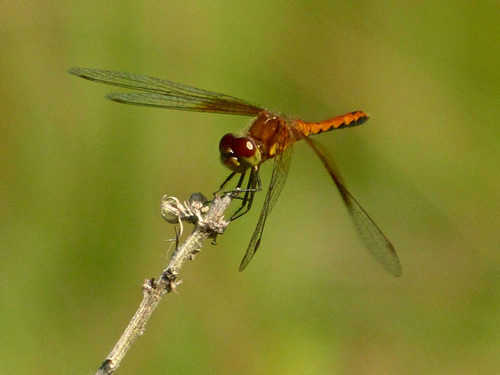
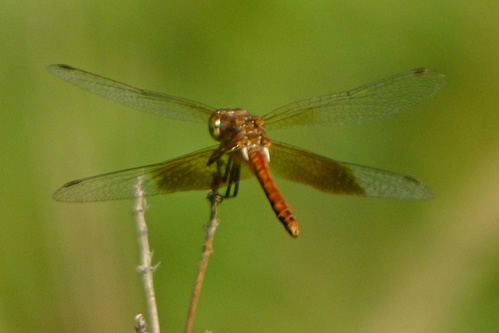
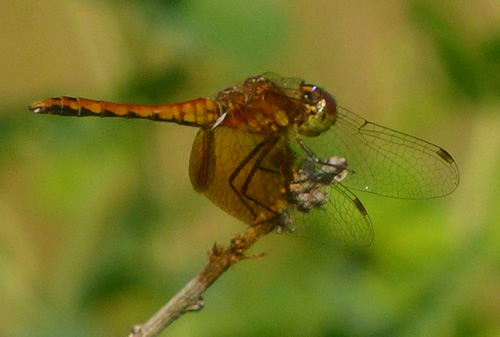
Observer: Paul Lauenstein
Observation Date: 6/26/15
Observation Time: 4:30 p.m.
Observation Location: Town-owned land at Morse and Lakeview Streets
Common Name: Banded Hairstreak butterfly
Scientific Name: Satyrium calanus
Comments: This small butterfly was feeding on milkweed blossoms. Banded hairstreaks are very similar to striped hairstreaks. The blue marginal spot on the hind wing is capped with orange in the striped hairstreak but not in the banded hairstreak.
More Information: Massachusetts Butterfly Club
Observer: Paul Lauenstein
Observation Date: 8/6/11
Observation Time: 8:10 a.m.
Observation Location: 4 Gavins Pond Road (back yard)
Common Name: Banded Net-Winged Beetle
Scientific Name: Calopteron discrepans
Comments: This colorful beetle is found throughout the eastern U.S. Its bright color and contrast warn predators that they taste bad if eaten.
More Information: University of Florida
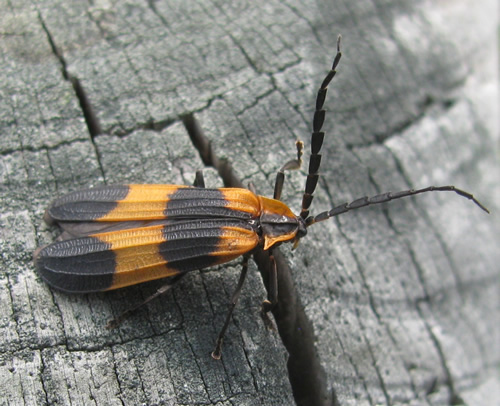
Observer: Paul Lauenstein
Observation Date: 9/4/20
Observation Time: 2:15 p.m.
Observation Location: Moose Hill Farm (TTOR)
Common Name: Bee fly
Scientific Name: Systropus macer
Comments: This fly looks like a wasp. It was feeding on a late purple aster blossom beside the dirt road under the power lines.
More Information: Forestry Images and Bugguide.net
Observer: Regen Jamieson
Observation Date: 8/11/09
Observation Location: Moose Hill in the meadow at the end of the “unnatural trail”.
Common Name: Black and Yellow Garden Spider
Scientific Name: Argiope aurantia
Comments: Males range from 5 to 9 mm; females from 19 to 28 mm. Like other members of Argiope they are considered harmless to humans.The female of the species grows much larger than the male. Females have large rounded bodies that may grow to 40 mm (1 1/2 inches), excluding the legs. If the length of the legs is added, the female can reach 75 mm (3″) in diameter. Males are thin-bodied and only 20 mm (¾”) long. Garden Spiders often build webs in areas adjacent to open sunny fields where they stay concealed and protected from the wind. The spider can also be found along the eaves of houses and outbuildings or in any tall vegetation where they can securely stretch a web. The circular part of the female’s web may reach two feet in diameter. Webs are built at elevations from two to eight feet off the ground. Female Argiope aurantia spiders tend to be somewhat local, often staying in one place throughout much of their lifetime. After mating, the male dies, and is sometimes then eaten by the female. She lays her eggs at night on a sheet of silky material, then covers them with another layer of silk, then a protective brownish silk. She then uses her legs to form the sheet into a ball with an upturned neck. Egg sacs range from 5/8″ to 1″ in diameter. She often suspends the egg sac right on her web, near the center where she spends most of her time. Each spider produces from one to four sacs with perhaps over a thousand eggs inside each. She guards the eggs against predation as long as she is able. However, as the weather cools, she becomes more frail, and dies around the time of the first hard frost. (from Wikipedia)
More Information: Animal Diversity Web
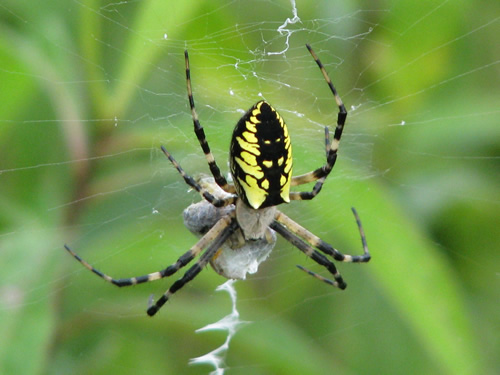
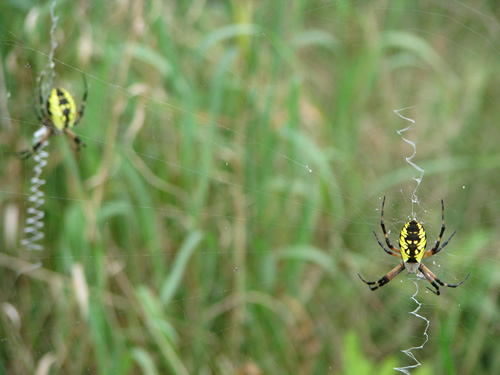
Observer: April Forsman
Observation Date: 9/24/10
Observation Time: 10:15 a.m.
Observation Location: DPW
Common Name: Black and Yellow Garden Spider
Scientific Name: Argiope aurantia
Comments: Males range from 5 to 9 mm; females from 19 to 28 mm. Like other members of Argiope they are considered harmless to humans.The female of the species grows much larger than the male. Females have large rounded bodies that may grow to 40 mm (1 1/2 inches), excluding the legs. If the length of the legs is added, the female can reach 75 mm (3″) in diameter. Males are thin-bodied and only 20 mm (¾”) long. Garden Spiders often build webs in areas adjacent to open sunny fields where they stay concealed and protected from the wind. The spider can also be found along the eaves of houses and outbuildings or in any tall vegetation where they can securely stretch a web. The circular part of the female’s web may reach two feet in diameter. Webs are built at elevations from two to eight feet off the ground. Female Argiope aurantia spiders tend to be somewhat local, often staying in one place throughout much of their lifetime. After mating, the male dies, and is sometimes then eaten by the female. She lays her eggs at night on a sheet of silky material, then covers them with another layer of silk, then a protective brownish silk. She then uses her legs to form the sheet into a ball with an upturned neck. Egg sacs range from 5/8″ to 1″ in diameter. She often suspends the egg sac right on her web, near the center where she spends most of her time. Each spider produces from one to four sacs with perhaps over a thousand eggs inside each. She guards the eggs against predation as long as she is able. However, as the weather cools, she becomes more frail, and dies around the time of the first hard frost. (from Wikipedia)
More Information: Animal Diversity Web
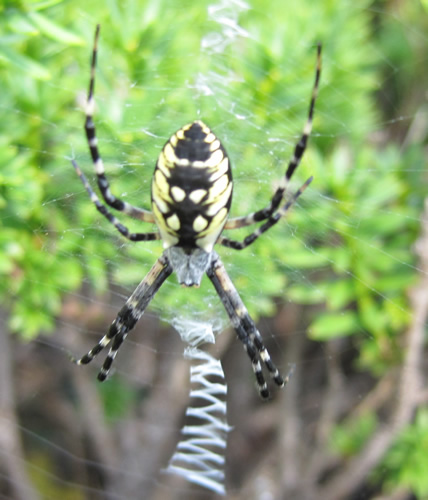
Observer: Paul Lauenstein
Observation Date: 5/30/20
Observation Time: 2:25 p.m.
Observation Location: Moose Hill Farm (The Trustees of Reservations)
Common Name: Black Swallowtail butterfly
Scientific Name: Papilio polyxenes
Comments: The big pasture at Moose Hill Farm is a good place to find black swallowtail butterflies (and other butterfly species as well). You can sometimes find bobolinks there as well.
Black swallowtail butterflies look a lot like spicebush swallowtail butterflies. You can learn how to tell the difference between a black swallowtail and a spicebush swallowtail at: http://www.naba.org/chapters/nabambc/frames-2species.asp?sp1=Papilio-polyxenes&sp2=Papilio-troilus
There is also a good discussion of how to tell the differences among four black butterfly species at: http://louisiananaturalist.blogspot.com/2009/06/four-dark-swallowtails.html
More Information: Butterflies and Moths of North America
I took this photo the following day in the same location:
Observer: Paul Lauenstein
Observation Date: 5/6/23
Observation Time: 9:45 a.m.
Observation Location: Moose Hill Audubon Wildlife Sanctuary
Common Name: Black Swallowtail butterfly
Scientific Name: Papilio polyxenes
Comments: I was surprised to see this black swallowtail butterfly so early in the season. It was feeding on the blossoms of a flowering tree near the barn on the Billings Loop.
Black swallowtail butterflies look a lot like spicebush swallowtail butterflies. You can learn how to tell the difference between a black swallowtail and a spicebush swallowtail at: http://www.naba.org/chapters/nabambc/frames-2species.asp?sp1=Papilio-polyxenes&sp2=Papilio-troilus
There is also a good discussion of how to tell the differences among four black butterfly species at: http://louisiananaturalist.blogspot.com/2009/06/four-dark-swallowtails.html
More Information: Butterflies and Moths of North America
Observer: Paul Lauenstein
Observation Date: 5/26/19
Observation Time: 12:20 p.m.
Observation Location: Moose Hill Farm (The Trustees of Reservations)
Common Name: Black Swallowtail butterfly
Scientific Name: Papilio polyxenes
Comments: The big meadow at Moose Hill Farm was alive with pairs of black swallowtails chasing each other on this glorious spring day. Black swallowtail butterflies look a lot like spicebush swallowtail butterflies. You can learn how to tell the difference between a black swallowtail and a spicebush swallowtail at: http://www.naba.org/chapters/nabambc/frames-2species.asp?sp1=Papilio-polyxenes&sp2=Papilio-troilus
There is also a good discussion of how to tell the differences among four black butterfly species at: http://louisiananaturalist.blogspot.com/2009/06/four-dark-swallowtails.html
More Information: Butterflies and Moths of North America
Observer: Paul Lauenstein
Observation Date: 5/28/23
Observation Time: 11:10 a.m.
Observation Location: Moose Hill Farm (TTOR)
Common Name: Black Swallowtail butterfly
Scientific Name: Papilio polyxenes
Comments: Black swallowtail butterflies look a lot like spicebush swallowtail butterflies. You can learn how to tell the difference between a black swallowtail and a spicebush swallowtail at: http://www.naba.org/chapters/nabambc/frames-2species.asp?sp1=Papilio-polyxenes&sp2=Papilio-troilus
There is also a good discussion of how to tell the differences among four black butterfly species at: http://louisiananaturalist.blogspot.com/2009/06/four-dark-swallowtails.html
More Information: Butterflies and Moths of North America
Observer: Paul Lauenstein
Observation Date: 6/2/19
Observation Time: 2:15 p.m.
Observation Location: rocky bluff under power lines along S. Walpole St.
Common Name: Black Swallowtail butterfly
Scientific Name: Papilio polyxenes
Comments: Black swallowtail butterflies look a lot like spicebush swallowtail butterflies. You can learn how to tell the difference between a black swallowtail and a spicebush swallowtail at: http://www.naba.org/chapters/nabambc/frames-2species.asp?sp1=Papilio-polyxenes&sp2=Papilio-troilus
There is also a good discussion of how to tell the differences among four black butterfly species at: http://louisiananaturalist.blogspot.com/2009/06/four-dark-swallowtails.html
More Information: Butterflies and Moths of North America
Observer: Paul Lauenstein
Observation Date: 7/2/15
Observation Time: 2:00 p.m.
Observation Location: Moose Hill Farm (The Trustees of Reservations)
Common Name: Black Swallowtail butterfly
Scientific Name: Papilio polyxenes
Comments: This is one of my favorite photos for three reasons. First, it’s a good photo that shows clearly what this beautiful butterfly looks like. Second, black swallowtails are much less common in Sharon than similar spicebush swallowtails. And third, I had to try long and hard to find and photograph this specimen. You can learn how to tell the difference between a black swallowtail and a spicebush swallowtail at: http://www.naba.org/chapters/nabambc/frames-2species.asp?sp1=Papilio-polyxenes&sp2=Papilio-troilus
More Information: Butterflies and Moths of North America
Observer: Paul Lauenstein
Observation Date: 7/7/18
Observation Time: 12:00 p.m.
Observation Location: Moose Hill Farm (The Trustees of Reservations)
Common Name: Black Swallowtail butterfly
Scientific Name: Papilio polyxenes
Comments: Black swallowtail butterflies look a lot like spicebush swallowtail butterflies. You can learn how to tell the difference between a black swallowtail and a spicebush swallowtail at: http://www.naba.org/chapters/nabambc/frames-2species.asp?sp1=Papilio-polyxenes&sp2=Papilio-troilus
More Information: Butterflies and Moths of North America
Observer: Paul Lauenstein
Observation Date: 4/3/14
Observation Time: 2:45 p.m.
Observation Location: Gavins Pond area
Common Name: Blister Beetle
Scientific Name: Tricrania sanguinipennis
Comments: Blister beetles receive their common name from the ability of their hemolymph to produce blistering on contact with human skin. Hemolymph is often exuded copiously by reflexive bleeding when an adult beetle is pressed or rubbed. Blisters commonly occur on the neck and arms, as the result of exposure to adult beetles attracted to outdoor lights at night.
The blistering agent is cantharidin, an odorless terpene (exo-1,2-cis-dimethyl-3,6-ep- oxyhexahydro-phthalic anhydride) occurring elsewhere only in beetles of the family Oedemeridae (Arnett 2008). Cantharidin or cantharides (dried, pulverized bodies of adult beetles) was once employed extensively in human and veterinary medicine, primarily as a vesicant and irritant and is still used in the U.S. as the active ingredient in a proprietary wart remover (Epstein and Epstein 1960, Kartal Durmazlar et al, 2009). Taken internally or absorbed through the skin, cantharidin is highly toxic to mammals. There is an extensive literature dealing with its reputed aphrodisiacal properties and numerous reports of human poisonings, both accidental and deliberate. Source: http://entnemdept.ufl.edu/creatures/urban/medical/blister_beetles.htm
More Information: PBase

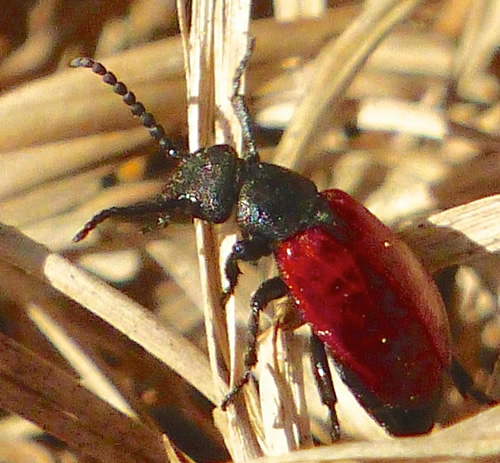
Observer: Paul Lauenstein
Observation Date: 7/19/10
Observation Time: 5:20 a.m.
Observation Location: Gavins Pond soccer field parking lot
Common Name: Blue Dasher dragonfly
Scientific Name: Pachidiplax longipennis
Comments: Female is brown with red eyes and yellow markings. Male is blue with green eyes.
More Information: Wikipedia
Female:
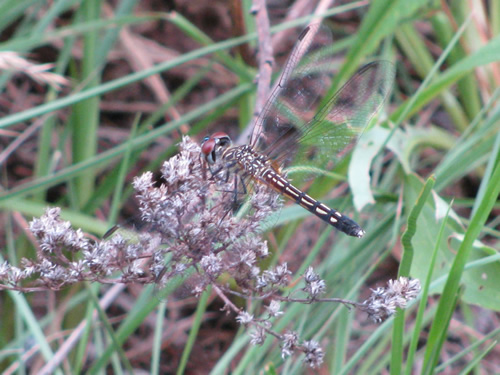
Male:
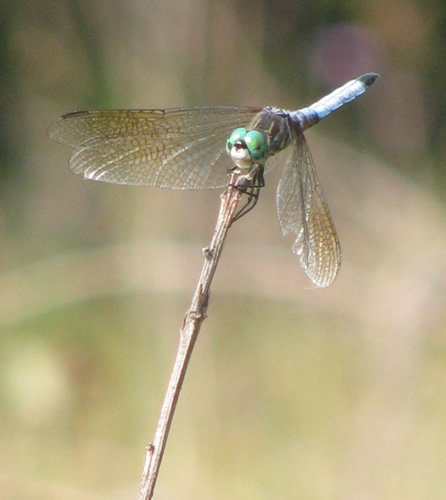
Observer: Paul Lauenstein
Observation Date: 7/15/13
Observation Time: 4:15 p.m.
Observation Location: Gavins Pond area
Common Name: Blue Dasher dragonfly (female)
Scientific Name: Pachidiplax longipennis
Comments: The male has a blue abdomen, hence the name.
More Information: Wikipedia
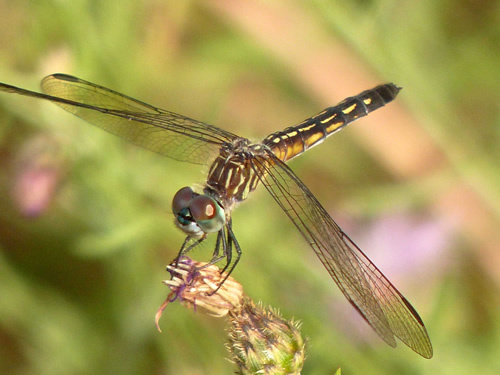
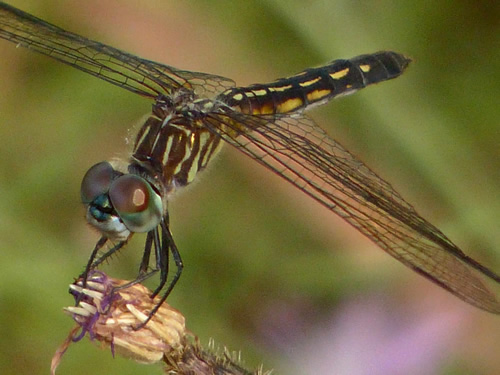
Observer: Paul Lauenstein
Observation Date: 7/8/13
Observation Time: 5:10 p.m.
Observation Location: near Gavins Pond Dam
Common Name: Blue Dasher dragonfly (male)
Scientific Name: Pachidiplax longipennis
More Information: http://www.cirrusimage.com/dragonfly_blue_dasher.htm
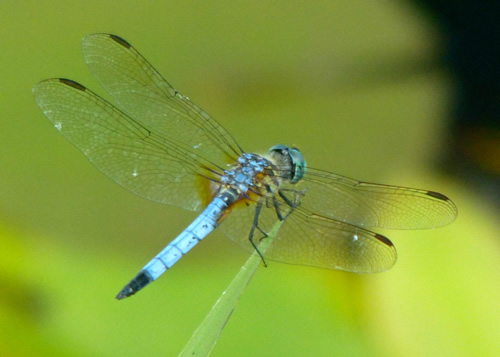
Observer: Paul Lauenstein
Observation Date: 5/12/12
Observation Time: 5:00 p.m.
Observation Location: Gavins Pond area
Common Name: Brown Elfin Butterfly
Scientific Name: Callophrys augustinus
Comments: This brown elfin was found in the same meadow of wild indigo as a rare frosted elfin butterfly.
More Information: Butterflies and Moths
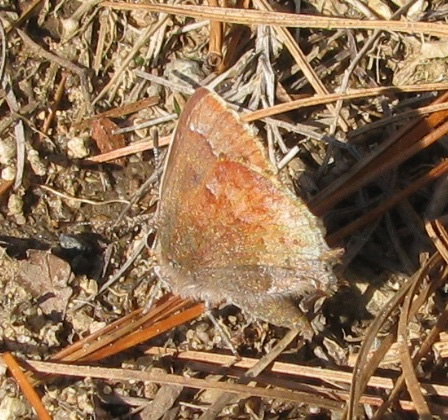
Observer: Faith Berkland
Observation Date: 6/20/14
Observation Time: 10:30 a.m.
Observation Location: On one of the reflectors I have around my driveway.
Common Name: Brown Mantidfly
Scientific Name: Clineriella Brunnea
Comments: I first thought it was a praying mantis but none of the pictures showed one that small, or with the wasp-like abdomen. I decided to see if it was a type of wasp and voila! See this photo.
More Information: Wikipedia
Observer: Paul Lauenstein
Observation Date: 11/11/21
Observation Time: 2:10 p.m.
Observation Location: Gavins Pond Rd. (my back yard)
Common Name: Brown Marmorated Stink Bug (adult)
Scientific Name: Halyomorpha Halys
Comments: Stink bugs molt several times before reaching maturity. Each phase is referred to as an instar.
More Information: Featured Creatures
Observer: Paul Lauenstein
Observation Date: 5/30/23
Observation Time: 10:15 a.m.
Observation Location: Gavins Pond Rd. (appeared on the desk in my living room!)
Common Name: Brown Marmorated Stink Bug (adult)
Scientific Name: Halyomorpha Halys
Comments: Stink bugs molt several times before reaching maturity. Each phase is referred to as an instar.
More Information: Featured Creatures
Observer: Paul Lauenstein
Observation Date: 8/31/18
Observation Time: 4:10 p.m.
Observation Location: Borderland State Park
Common Name: Brown Marmorated Stink Bug (4th instar)
Scientific Name: Halyomorpha Halys
Comments: Stink bugs molt several times before reaching maturity. Each phase is referred to as an instar.
More Information: Wikipedia
Observer: Faith Berkland
Observation Date: 9/22/15
Observation Time: 3:00 p.m.
Observation Location: Mansfield Street
Common Name: Brown-hooded Owlet Moth caterpillar
Scientific Name: Cucullia convexipennis
Comments: The moth flies from May to September depending on the location. The caterpillars feed on Aster, Solidago and Callistephus chinensis.
More Information: Wikipedia
Observer: Paul Lauenstein
Observation Date: 7/9/11
Observation Time: 3:00 p.m.
Observation Location: Field near Gavins Pond
Common Name: Buckeye Butterfly
Scientific Name: Junonia coenia
Comments: This bedraggled specimen is showing a lot of wear and tear on its wings.
More Information: Wikipedia
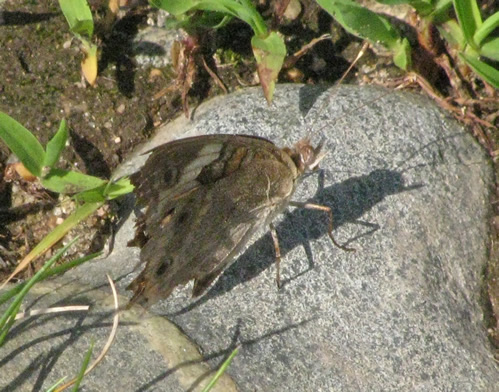
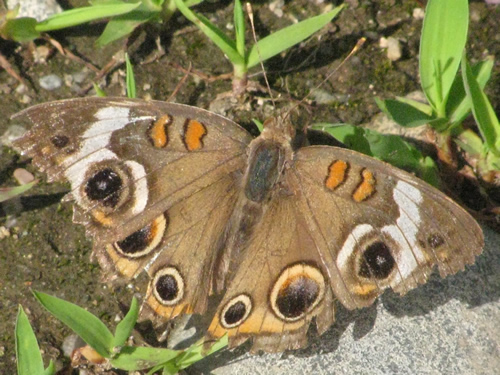
Observer: Paul Lauenstein
Observation Date: 6/29/10
Observation Time: 7:50 a.m.
Observation Location: Gavins Pond Road area
Common Name: Bumble Bee
Scientific Name: Bombus sp.
Comments: Bumblebees are important pollinators. There are many species of bumblebees.
More information: Bumblebees of the Eastern United States
Observer: Paul Lauenstein
Observation Date: 3/17/11
Observation Time: 3:10 p.m.
Observation Location: vernal pool near Bay Road
Common Name: Caddisfly Larva
Scientific Name: Order Trichoptera
Comments: Caddisfly larva are aquatic. They build a protective case of silk around themselves, incorporating debris for camouflage and protection. Their presence is indicative of good water quality. Adult caddis flies emerge en masse for just a few weeks. After emergence, they do not eat, but they mate and the females lay eggs. Caddisflies are a preferred food of trout.
More Information: Watersheds.org
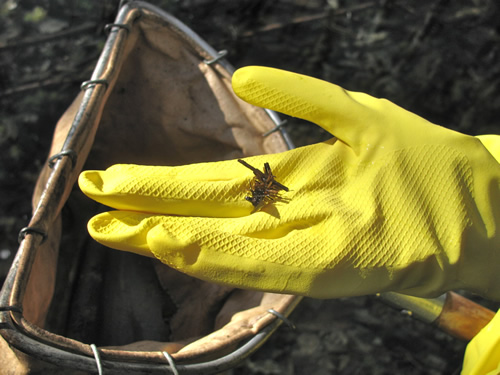
Observer: Paul Lauenstein
Observation Date: 8/30/10
Observation Time: 8:30 a.m.
Observation Location: Gavins Pond Road (bridge near soccer fields)
Common Name: Canada Darner dragonfly
Scientific Name: Aeshna canadensis
Comments: Canada darner dragonflies are very common in Massachusetts in late summer near sluggish marsh-bordered streams. They typically hang vertically at rest.
More Information: US Army Corps of Engineers: North Hartland Lake
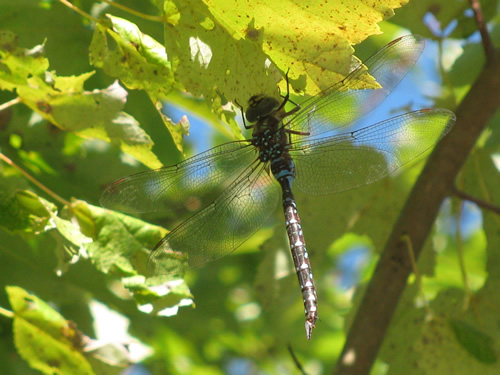
Observer: Paul Lauenstein
Observation Date: 9/12/09
Observation Time: 11:15 a.m.
Observation Location: Gavins Pond Dam
Common Name: Carolina Locust
Scientific Name: Dissosteira carolina
Comments: Diagnostic pronotum ridge is clearly visible in the photo.
More Information: e-Nature.com
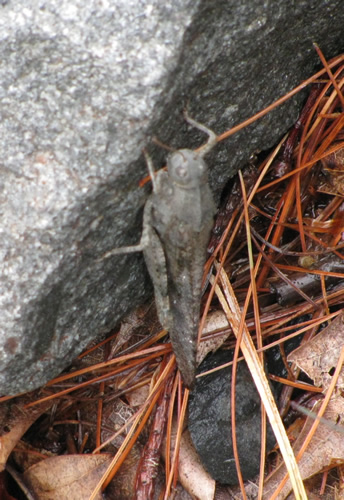
Observer: Paul Lauenstein
Observation Date: 6/26/10
Observation Time: 3:20 p.m.
Observation Location: Beaver Brook headwaters area
Common Name: Carpenter Ant “Frass”
Scientific Name: genus Camponotus
Comments: Unlike termites, carpenter ants don’t eat wood. They cannot digest cellulose, but they chew galleries in wood for their nests. They excavate wood, leaving telltale piles of sawdust called “frass.”
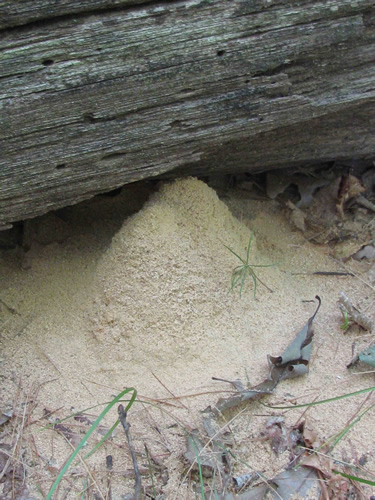
Observer: Paul Lauenstein
Observation Date: 5/11/23
Observation Time: 10:00 a.m.
Observation Location: Moose Hill Audubon Wildlife Sanctuary (Billings Loop barn)
Common Name: Carpenter Bee
Scientific Name: Xylocopa virginica
Comments: Carpenter bees look like bumblebees, but they have a completely black, shiny, hairless abdomen (the rear section). They mate in April or May. The female carpenter bee starts looking for a suitable nest site, such as weathered areas on buildings, fences, or telephone poles. She chews a hole into the wood and lays her eggs. Adult carpenter bees emerge in August but return to the nest to overwinter. Male carpenter bees hover near the holes that the females bore into wood but they cannot sting. Only the females can sting.
Carpenter bee tunnels occasionally cause minor damage to wooden buildings (note the holes in the wood in the photos). Carpenter bees can be deterred by hanging a fake hornet nest nearby.
More information: Mass Audubon
Observer: Rita Corey
Observation Date: 8/13/20
Observation Time: 3:45 p.m.
Observation Place: Mountain St.
Common Name: Cecropia Moth (coccoon phase)
Scientific Name: Hyalophora cecropia
Comments: The cecropia moth is the largest North American moth. It has a wingspan of 5-6 inches. It is a very colorful moth.
The female cecropia moth lays rows of eggs on both sides of a leaf on a tree or shrub. The eggs hatch in 10-14 days and the caterpillars begin eating the host tree or shrub’s leaves. The cecropia cocoon is crescent shaped. There is one generation of cecropia born each year.
After emerging from the coccoon, the mature cecropia moth does not eat. It’s only purpose it to mate. It only lives for a few weeks. Despite its dramatic size and bright coloration, it is seldom seen because it is nocturnal.
More Information: Nature Works
Three cecropia moth coccoons:
Observer: Paul Lauenstein
Observation Date: 5/9/23
Observation Time: 7:40 a.m.
Observation Location: Moose Hill Audubon Wildlife Sanctuary
Common Name: Cecropia Moth cocoon
Scientific Name: Hyalophora cecropia
Comments: I used an app called SEEK to identify this strange thing I spotted beside the trail.
More Information: Cecropia Moth
Observer: Josh Simons
Observation Date: 5/31/20
Observation Time: 2:00 p.m.
Observation Location: Moose Hill area
Common Name: Chalk-fronted corporal dragonfly (male)
Scientific Name: Ladona julia
Comments: This species of skimmer dragonfly is typically observed near local marshes and lakes with a decaying organic substrate.
More Information: geocities
Observer: Paul Lauenstein
Observation Date: 6/2/19
Observation Time: 3:10 p.m.
Observation Location: beneath the high tension wires that parallel So. Walpole Street
Common Name: Chalk-fronted Corporal dragonfly (juvenile)
Scientific Name: Ladona julia
Comments: Juveniles of both sexes are light reddish brown, with white shoulder stripes and a black stripe down the middle of the abdomen. This one seemed a bit wobbly, as if it had just emerged.
More Information: Wikipedia
Observer: Marshall Katler
Observation Date: 7/31/23
Observation TIme: 6:30 p.m.
Observation Location: Mansfield St.
Common Name: Cicada (a.k.a. Dogday Cicada)
Scientific Name: Neotibicen canicularis
Comments: This cicada was just hanging onto a sheet hung outside. It was there from at least late morning to 8:30 PM and longer. It was not there in the morning. It barely moved the entire time it was observed.
One genus of cicadas, the periodical cicadas, spend most of their lives as underground nymphs, emerging only after 13 or 17 years. The unusual duration and timing of their emergence may reduce the number of cicadas lost to predation, both by making them a less reliably available prey (so that any predator who evolved to depend on cicadas for sustenance might starve waiting for their emergence), and by emerging in such huge numbers that they will satiate any remaining predators before losing enough of their number to threaten their survival as a species.
The annual cicadas are species that emerge every year. Though these cicadas have lifecycles that can vary from one to nine or more years as underground larvae, their emergence above ground as adults is not synchronized, so some members of each species appear every year.
Cicadas have been featured in literature since the time of Homer’s Iliad, and as motifs in art from the Chinese Shang dynasty. They have also been used in myth and folklore as symbols of carefree living and immortality. The cicada is also mentioned in Hesiod’s Shield (ll.393–394), its voice sings when millet first ripens. Cicadas are eaten by human beings in various countries, including China, where the nymphs are served deep-fried in Shandong cuisine.
More Information: bugguide.net and Wikipedia
Observer: Josh Simons
Observation Date: 8/13/2016
Observation TIme: 3:00 p.m.
Observation Location: Moose Hill area
Common Name: Cicada (a.k.a. Dogday Cicada)
Scientific Name: Neotibicen canicularis
Comments: One genus, the periodical cicadas, spend most of their lives as underground nymphs, emerging only after 13 or 17 years. The unusual duration and timing of their emergence may reduce the number of cicadas lost to predation, both by making them a less reliably available prey (so that any predator who evolved to depend on cicadas for sustenance might starve waiting for their emergence), and by emerging in such huge numbers that they will satiate any remaining predators before losing enough of their number to threaten their survival as a species.
The annual cicadas are species that emerge every year. Though these cicadas have lifecycles that can vary from one to nine or more years as underground larvae, their emergence above ground as adults is not synchronized, so some members of each species appear every year.
Cicadas have been featured in literature since the time of Homer’s Iliad, and as motifs in art from the Chinese Shang dynasty. They have also been used in myth and folklore as symbols of carefree living and immortality. The cicada is also mentioned in Hesiod’s Shield (ll.393–394), its voice sings when millet first ripens. Cicadas are eaten by human beings in various countries, including China, where the nymphs are served deep-fried in Shandong cuisine.
More Information: bugguide.net and Wikipedia
Observer: Paul Lauenstein
Observation Date: 8/6/12
Observation Time: 1:25 p.m.
Observation Location: near Gavins Pond Dam
Common Name: Cicada Killer Wasp
Scientific Name: Sphecius speciosus
Comments: These large, fearsome-looking wasps burrow in the ground. They are actually not aggressive. I found a sandy area near the Gavins Pond Dam that was peppered with their holes. It took a while to figure out that these holes were made by the wasps.
More Information: University of Kentucky
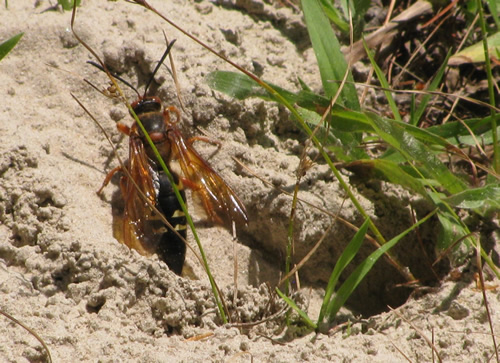
Cicada killer wasp emerging from its burrow:
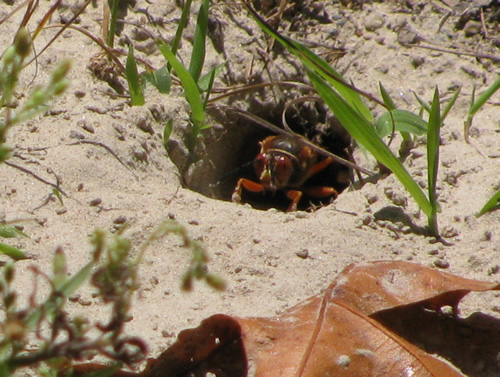
Cicada killer wasp burrows:
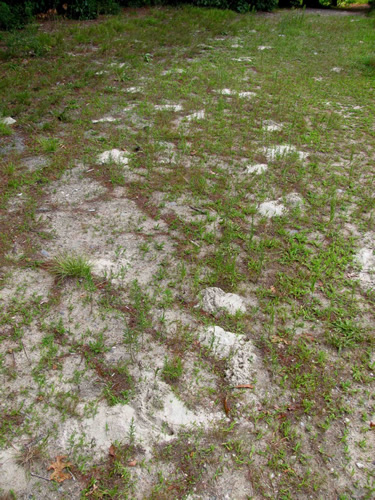
Cicada killer wasp burrow:
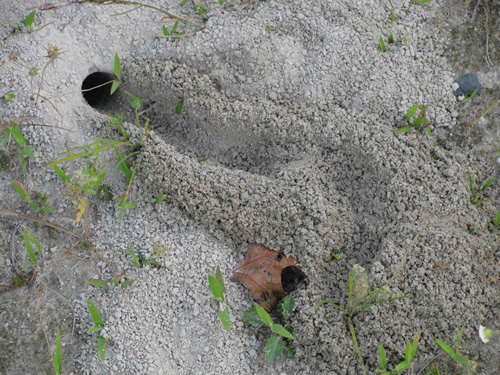
Observer: Paul Lauenstein
Observation Date: 8/30/11
Observation Location: Gavins Pond Road by soccer field parking lot
Common Name: Clouded Sulphur butterfly
Scientific Name: Colias philodice
Comments: This butterfly was hard to photograph because it would not hold still! Note the big green eyes and the spots on the wing.
More Information: Wisconsin Butterflies
Observer: Paul Lauenstein
Observation Date: 9/4/20
Observation Time: 1:00 p.m.
Observation Location: Moose Hill Farm (TTOR)
Common Name: Clouded Sulphur butterfly
Scientific Name: Colias philodice
Comments: A common butterfly seen from late April to mid-October. This patch of blooming Joe Pye weed was alive with clouded sulphurs feeding on the nectar. Note the big green eyes.
More Information: Massachusetts Butterfly Club
Observer: Paul Lauenstein
Observation Date: 7/2/11
Observation Time: 2:45 p.m.
Observation Location: Soccer field parking lot off Gavins Pond Road
Common Name: Clover Looper Moth
Scientific Name: Caenurgina crassiuscula
Comments: This moth stopped to rest on the soccer field parking lot, allowing me to get close enough for this shot. I got the ID from bugguide.net.
More Information: A Prairie Haven
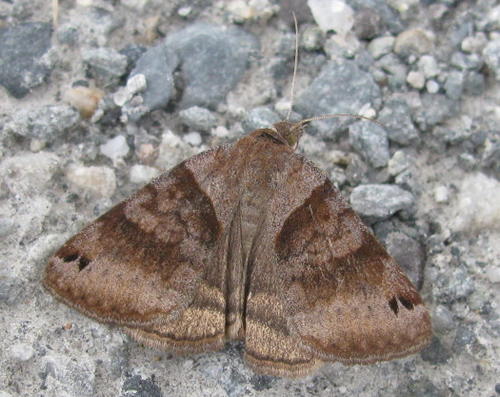
Observer: Gaurav Shah
Observation Date: 8/2/23
Observation Time: 3:00 p.m.
Observation Location: Arboro Drive
Common Name: Clymene Moth
Scientific Name: Haploa clymene
Comments: Unlike most moths, the Clymene moth is equally active both day and night. It also prefers moist areas and can be found near wetlands and water sources. At night, it is attracted to lights.
The Clymene moth is often found near wet areas such as wetlands, and visits flowers to drink the nectar using its long proboscis.
More Information: Wikipedia
Observer: Paul Lauenstein
Observation Date: 9/22/11
Observation Time: 3:05 p.m.
Observation Location: Gavins Pond Dam
Common Name: Cobbler moth
Scientific Name: Condica sutor
Comments: There are over 10,000 species of moths in North America. Identifying them can be a challenge, but there are some good online resources such as the Bug Guide.
More Information: Bug Guide
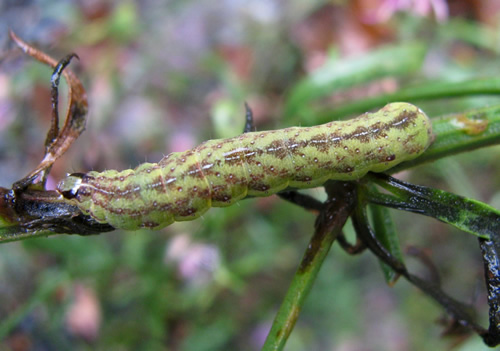
Observer: Gaurav Shah
Observation Date: 9/3/2019
Observation Time: N/A
Observation Location: Borderland State Park, Northwest Trail
Common Name: Cockroach Wasp
Scientific Name: Dolichurus cf. bicolor
Comments: There are no existing records of this genus in the country in iNaturalist, and only one in BugGuide (which was in Arkansas). This species has one of the most remarkable adaptations in all of nature: they are able to remove the cockroach’s ability to choose to flee, without removing the cockroach’s ability to move, effectively turning it into a zombie that they can lead around.
More information: https://bugguide.net/node/view/22211
Observer: Gaurav Shah
Observation Date: 9/3/2019
Observation Time: N/A
Observation Location: Borderland State Park, Northwest Trail
Common Name: Cockroach Wasp
Scientific Name: Podium luctuosum
Comments: This is the first record of this genus in Massachusetts according to BugGuide, and only the second in New England (there are other existing records from iNaturalist).
More information: https://bugguide.net/node/view/202008
Observer: Paul Lauenstein
Observation Date: 6/1/13
Observation Time: 4:00 p.m.
Observation Location: Ward’s Berry Farm
Common Name: Colorado Potato Beetle
Scientific Name: Leptinotarsa decemlineata
Comments: These striking beetles were eating eggplant leaves. Colorado potato beetles have developed resistance to all known classes of pesticides.
More Information: Organic Garden Info
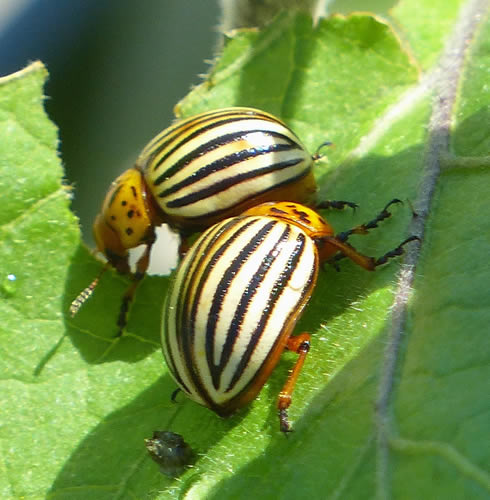
Observer: Paul Lauenstein
Observation Date: 5/26/15
Observation Time: 2:05 p.m.
Observation Location: 4 Gavins Pond Road
Common Name: Common Baskettail dragonfly
Scientific Name: Epitheca cynosura
Comments: This is the most common baskettail within its range, hence the name. The scientific name, cynosura, means dog tail, and possibly refers to the way the cerci at the end of the abdomen curve outward like a dog wagging its tail one way then the other.
More Information: Wikipedia
Observer: Paul Lauenstein
Observation Date: 6/2/11
Observation Time: 2:10 p.m.
Observation Location: Gavins Pond Dam
Common Name: Common Baskettail dragonfly
Scientific Name: Epitheca cynosura
Comments: This is the most common baskettail within its range (eastern North America), hence the name.
More Information: Wikipedia

Observer: Paul Lauenstein
Observation Date: 7/5/21
Observation Time: 2:20 p.m.
Observation Location: Maskwonicut St. (on the bridge over Beaver Brook)
Common Name: Common Green Bottle Fly
Scientific Name: Lucilia sericata
Comments: The common green bottle fly (Lucilia sericata) is a blowfly found in most areas of the world and is the most well-known of the numerous green bottle fly species. Its body is slightly larger than a house fly, and has brilliant, metallic, blue-green or golden coloration with black markings. It has short, sparse, black bristles (setae) and three cross-grooves on the thorax. The wings are clear with light brown veins, and the legs and antennae are black.
The larvae of the fly may be used for maggot therapy, are commonly used in forensic entomology, and can be the cause of myiasis in livestock and pets.
More Information: Wikipedia
Observer: Paul Lauenstein
Observation Date: 8/13/13
Observation Time: 1:00 p.m.
Observation Location: Gavins Pond area
Common Name: Common Green Darner dragonfly
Scientific Name: Anax junius
More Information: Idaho Museum of Natural History
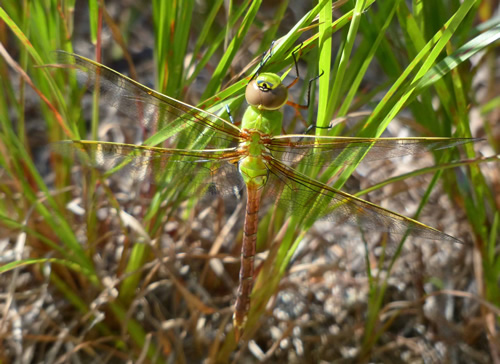
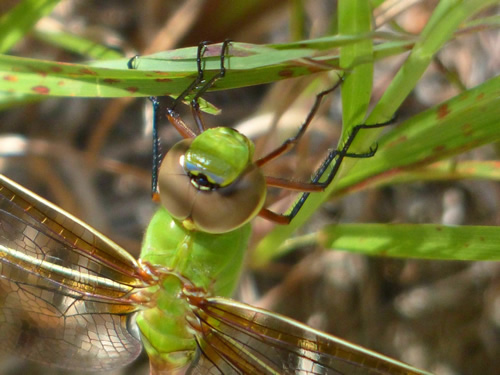
Observer: Paul Lauenstein
Observation Date: 6/25/11
Observation Time: 2:45 p.m.
Observation Location: Gavins Pond Dam
Common Name: Common Pondhawk dragonfly
Scientific Name: Erythemis simplicicollis
Comments: Female (males are blue)
More Information: Insects of West Virginia
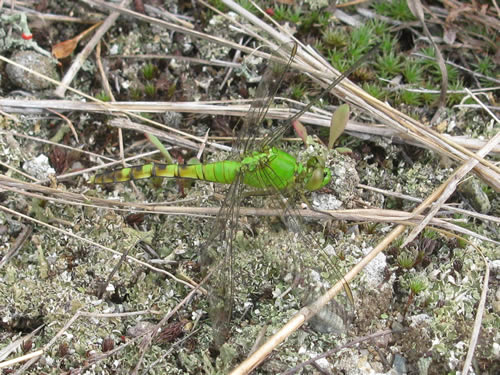
Observer: Josh Simons
Observation Date: 6/14/20
Observation Time: 1:15 p.m.
Observation Location: Moose Hill area
Common Name: Common Pondhawk (or Eastern Pondhawk) dragonfly (female)
Scientific Name: Erythemis simplicicollis
Comments: Pondhawk dragonflies are voracious hunters, but they are completely harmless to humans. Females are green. Males are blue. Females oviposit in flight, hovering low over the water and repeatedly dipping their abdomens into the water to release the eggs.
More Information: North American Insects and Spiders
Observer: Paul Lauenstein
Observation Date: 8/11/10
Observation Time: 8:35 a.m.
Observation Location: Gavins Pond Road (bridge near soccer fields)
Common Name: Common Pondhawk dragonfly (female)
Scientific Name: Erythemis simplicicollis
Comments: Pondhawk dragonflies are voracious hunters, but they are completely harmless to humans. Females are green. Males are blue. Females oviposit in flight, hovering low over the water and repeatedly dipping their abdomens into the water to release the eggs.
More Information: North American Insects and Spiders
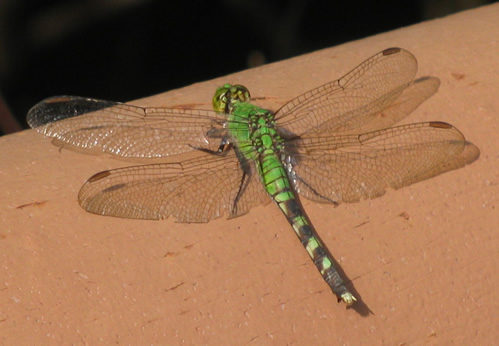
Observer: Paul Lauenstein
Observation Date: 7/9/10
Observation Time: 4:50 p.m.
Observation Location: Gavins Pond
Common Name: Common Pondhawk dragonfly (young male)
Scientific Name: Erythemis simplicicollis
Comments: Males are blue. Females are bright green. Voracious hunter near vegetated ponds and slow streams, but they are completely harmless to humans.
More Information: North American Insects and Spiders
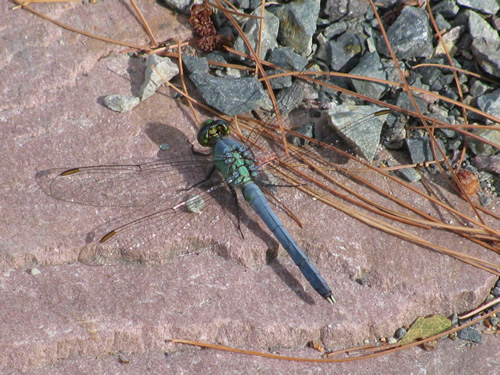
Observer: Paul Lauenstein
Observation Date: 5/27/19
Observation Time: 12:45 p.m.
Observation Location: Conservation land near Morse & Lakeview
Common Name: Common Ringlet butterfly
Scientific Name: Coenonympha tullia
Comments: Ringlets can be found in a variety of grassy habitats, including roadsides, woodland edges and clearings, prairies, bogs, and arctic and alpine taiga and tundra. It is an erratic flyer. It is a holarctic species found in northern Europe and Asia and across North America.
More Information: Wikipedia
Observer: Paul Lauenstein
Observation Date: 6/2/11
Observation Time: 1:30 p.m.
Observation Location: Gavins Pond Road near soccer field parking lot
Common Name: Common Ringlet butterfly
Scientific Name: Coenonympha tullia
Comments: Ringlets can be found in a variety of grassy habitats, including roadsides, woodland edges and clearings, prairies, bogs, and arctic and alpine taiga and tundra. It is a poor flyer, but can sometimes be found along ditches seeking new grounds. It is a holarctic species found in northern Europe and Asia and across North America.
More Information: Wikipedia
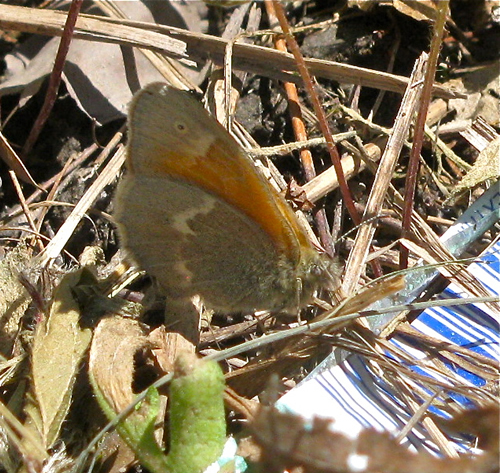
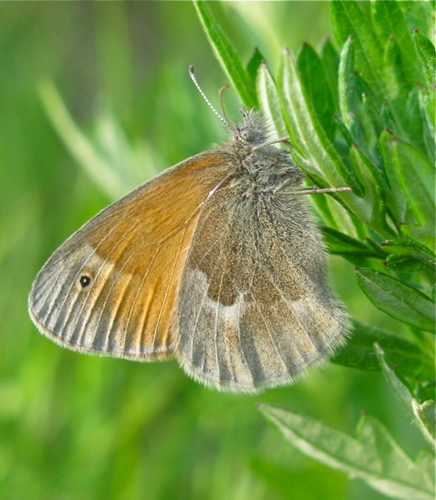
Observer: Paul Lauenstein
Observation Date: 6/9/20
Observation Time: 3:00 p.m.
Observation Location: meadow near Gavins Pond dam
Common Name: Common Ringlet butterfly
Scientific Name: Coenonympha tullia
Comments: Ringlets can be found in a variety of grassy habitats, including roadsides, woodland edges and clearings, prairies, bogs, and arctic and alpine taiga and tundra. It is an erratic flyer. It is a holarctic species found in northern Europe and Asia and across North America.
More Information: Wikipedia
Observer: Paul Lauenstein
Observation Date: 5/31/14
Observation Time: 4:05 p.m.
Observation Location: field near Gavins Pond dam
Common Name: Common Spring Moth
Scientific Name: Heliomata cycladata
Comments: Although the word “common” appears in its name, I have only seen this small but striking moth twice in Sharon.
More Information: Bug Guide
